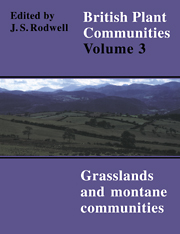Book contents
- Frontmatter
- Contents
- List of Figures
- Preface and Acknowledgements
- Preamble
- Mesotrophic Grasslands
- Community Descriptions
- Calcicolous Grasslands
- Community Descriptions
- Calcifugous Grasslands and Montane Communities
- Community Descriptions
- Index of Synonyms to Grasslands and Montane Communities
- Index of Species in Grasslands and Montane Communities
- Bibliography
U21 - Cryptogramma Crispa-Deschampsia Flexuosa Community
Published online by Cambridge University Press: 04 July 2020
- Frontmatter
- Contents
- List of Figures
- Preface and Acknowledgements
- Preamble
- Mesotrophic Grasslands
- Community Descriptions
- Calcicolous Grasslands
- Community Descriptions
- Calcifugous Grasslands and Montane Communities
- Community Descriptions
- Index of Synonyms to Grasslands and Montane Communities
- Index of Species in Grasslands and Montane Communities
- Bibliography
Summary
Synonymy
Cryptogramma crispa vegetation Leach 1930; Cryptogrammetum crispae Jenny-Lips 1930.
Constant species
Cryptogramma crispa, Deschampsia flexuosa, Festuca ovina, Galium saxatile, Campylopus flexuosus, Polytrichum formosum.
Rare species
Cryptogramma crispa.
Physiognomy
The Cryptogramma crispa-Deschampsia flexuosa community comprises pioneer vegetation of screes and tumbled boulders in which Cryptogramma crispa is the most abundant plant. Young stands have very few associates, beyond the patches of encrusting lithophytes such as Racomitrium fasciculare and Andreaea rupestris and cushions of bryophytes like Diplophyllum albicans, Racomitrium lanuginosum and R. heterostichum which are early invaders of the fragments of detritus that collect among the talus. These latter, particularly Diplophyllum, appear to provide a congenial surface for the development of the fern prothalli and sporophytes and, if there is some stability to the substrate, Cryptogramma can grow into clumps more than a metre or so across, the bright green patches of the curled and crispy foliage being distinct even from a distance. It is in this stage of growth, as the fronds decay each autumn but remain attached to the rhizomes accumulating a mass of rootbound humus, that the associated flora begins to develop, though many stands have a somewhat fragmentary composition, particularly where there is periodic shifting of the talus.
Among these plants, small tufts of fine-leaved grasses such as Deschampsiaflexuosa and Festuca ovina (including F. vivipara at higher altitudes) are very common and sometimes moderately abundant, with more occasionally a little Nardus stricta, Anthoxanthum odoratum, Agrostis capillaris and A. canina. Galium saxatile is constant and can form quite extensive patches and there are frequent individuals of Oxalis acetosella and Huperzia selago with, less commonly, Diphasium alpinum, Rumex acetosella, Digitalis purpurea and Potentilla erecta. Some stands are invaded by Vaccinium myrtillus, Calluna vulgaris or Erica cinerea but the cover of these sub-shrubs is never more than locally abundant.
Quite an extensive and varied bryophyte flora can develop among the patches of this vegetation subsequent to establishment of the fern, particularly where there is abundant shelter and shade. The most frequent species, apart from the early invaders, Diplophyllum and Racomitrium spp., are Campylopus paradoxus, Polytrichum formosum, Dicranum scoparium, D. majus, Hypnum cupressiforme, Pleurozium schreberi, Rhytidiadelphus loreus, Polytrichum alpinum, Pogonatum urnigerum, Plagiothecium undulatum, Ptilidium ciliare, Isopterygium elegans, Lophozia ventricosa and Barbilophozia floerkii. Some lichens can also be patchily abundant, with occasional records for Cladonia impexa, C. squamosa, C. uncialis and C. furcata.
- Type
- Chapter
- Information
- British Plant Communities , pp. 499 - 502Publisher: Cambridge University PressPrint publication year: 1992

